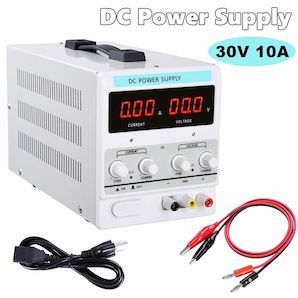
Curated with aloha by
Ted Mooney, P.E. RET

The authoritative public forum
for Metal Finishing 1989-2025

-----
Copper electroforming problems
for Artisans, Jewelry, Crafts

avail from eBay, AbeBooks or Amazon
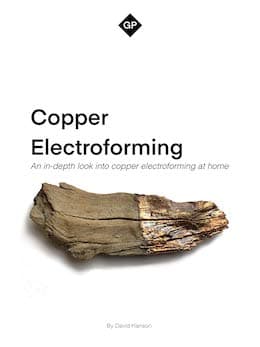
avail from Amazon

avail from Amazon
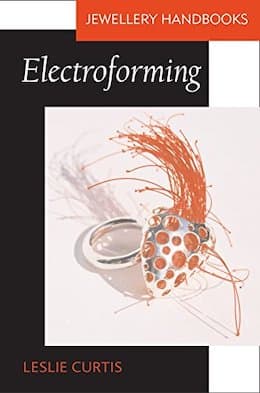
avail from eBay, AbeBooks or Amazon
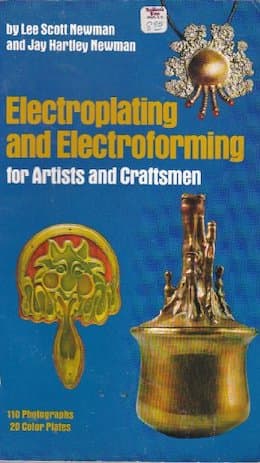
avail from eBay, AbeBooks or Amazon
(as an Amazon Associate & eBay Partner, we earn from qualifying purchases)
Q. Hi, I just started electroplating and I am running into issues! I am using a 3 amp rectifier with the solution from Rio and a conductive solution from safer solution. This is my second try and it came out worse then the first! The copper seems to not be bonding to, well, anything! It is just balling up on my piece and wipes right off! The first piece came out mostly okay and half did just the same, just wiped off. It is coming out the right color so I'm not sure what I'm doing wrong. Any help would be greatly appreciated!
Jennifer Peonejewelry - Hauser Idaho usa
March 23, 2016
A. Hi Jennifer. Pretreatment is 90% of plating for most people. What is your jewelry made of, and how have you assured yourself that it is spotlessly clean and properly activated. If the jewelry is a conductive metal, why are you coating it with conductive solution? Your problem may be in the plating tank, but it may not be.
Regards,

Ted Mooney, P.E. RET
Striving to live Aloha
finishing.com - Pine Beach, New Jersey
Q. Ted,
Thank you for getting back to me so fast! So I am using a two-part epoxy to set stones on a small pendant that is on a bale made of copper. I am O l painting the epoxy and the copper is cleaned before placing it into the tank. As far as my set up goes I have it in a large half gallon glass jar with, I think, copper coiled inside of it. According to my rectifier I am getting a good flow.
- Hauser Idaho usa
Q. Thank you for this opportunity to express my problems. I have a small artist studio and my problem is trying to electroform concave areas on silicone rubber mold with a copper solution . I have the correct paint but it looks like it's peeling off most of the time, the top areas of the mold are getting plated well but the lowest ones are not and my question is what am I doing wrong. the liquids that I use for my tank are coming from a professional distributor here in Los Angeles and my tank size is 3 feet by 2 feet by 2 feet I'm using a rectifier with a range up to 100 amps so I've got plenty of electricity. My molds are usually in the vicinity of 8 inches x 4 inches. I am using the formula of 1th of an amp for every in of plating surface. I will really be happy to get an answer to my problem thank you.
mario jasonsculptor - sherman oaks, California, U.S.A.
March 30, 2016
----
Ed. note: There is a typo in your posting, Mario. Perhaps you meant 1/10th of an Amp/sq. in.?
Hi Jennifer, Hi Mario. The basic issue for jeweler-hobbyists is that if all goes well the electroform works, but if there is a small slip in any of a hundred little things they're not likely to have any idea what to do to correct it because they have little relevant experience.
Even Renoir and Monet did charcoal sketches before trying to commit a scene to oil. So practice on some old coins. Buy some Hull Cell panels and plate them. Bend them in half to see how well the plating sticks. Plate them at 5X your present current density, and at 1/5, and see what happens. Scrub them with pumice before plating. Apply some masking material to see the strengths and weaknesses of approaches. There is no substitute for experience.
Jennifer: after you've practiced with copper panels, paint some stripes of that epoxy on some flat copper panels so you can really see what is going on with regards to the adhesion.
Mario: The amount of plating deposited at any spot is proportional to the current flowing to that spot, and the current takes the shortest path through the solution from the anode to the cathode. Are you sure the anode is no further from the bottom of the mold than from the top areas? If the paint is not sticking to the rubber and you can't make it stick, I'm not so sure that it's "the correct paint".
Luck and Regards,

Ted Mooney, P.E. RET
Striving to live Aloha
finishing.com - Pine Beach, New Jersey
Q. Hello and thank you for a wonderful forum. I am trying to copper plate baby shoes, dummies, bottles, etc., and have been experiencing about 4 issues that may or may not be solved with one solution. Ok here goes …
1. When I place my cathode/job in the tank the amps start where they should depending on the size of the cathode but after about 5 mins they start dropping. Slowly at first and then quite rapidly, and within 7-8 mins the amps are down to 2-0.2amps. If I leave it alone, sometimes it creeps back up to around half of what they initially where. What can I do to stop amps from dropping? The solution is brand new from one of the largest reputable suppliers in the country. The rectifier has been checked and it's perfect. I have good agitation and I'm using phosphorus copper anode in anode bags. The temperature of the bath is around 23 °C. So I go around in circles … the solution company says it's the rectifier, the rectifier guy says it's the anodes, the anode company says it's my application … and around we go again!
2. I'm not getting a nice black coating on the anodes. It's more of a reddish brown colour and I see this reddish brown silt seep into the solution through the anode bags.
4. I sometimes get those blue crystals which I believe are copper sulphate
⇦ this on
eBay or
Amazon [affil links] crystals on the anode which is inside the anode bag.
3. I'm not achieving a nice bright finish. It is consistently a dull pink/salmon colour.
As I said, I'm not sure if all these issues are related to one problem or if they are all separate problems. Any advise will be greatly appreciated. Thanks again for a wonderful informative forum.
Kind regards,
Tinker - Durban south africa
May 12, 2016
Q. I've been Electroforming with ease for a few years now; however, lately my pieces are coming out of the bath glittery and very brittle.
I had been using some copper tubing as an anode which I don't believe to be that pure; I've since switched to a more pure copper sheet. I also added maybe a bit too much brightener just before I started getting my poor results.
So my question is, what is causing the glittery and brittle plate. Too much brightener? Or possibly depleted copper solution from using an alloyed anode? And what would you suggest to fix this? Thanks so much!
- Alberta, Canada
May 24, 2016
A. Hi Kelsie. Too much brightener is probably the chief problem, although maybe not the only problem.
What works to remove many/most brighteners is carbon treatment, hot, and possibly with peroxide first. Your copper plating solution should have a technical data sheet that talks about this. Treatment must be done in a separate tank and then filtered back, because you'll "never" get the carbon out if it's in your operating tank.
If this sounds too technical, or like too much work, replacing the solution is probably an option.
Regards,

Ted Mooney, P.E. RET
Striving to live Aloha
finishing.com - Pine Beach, New Jersey
Salmon pink vs bright copper finish from electroforming
Q. My setup:
-- 30V/5A variable DC power supply
-- Midas bright electro-forming copper solution (1qt)
-- small glass container roughly 5"x3"x5"
-- anode is a length (approx. 30") of 1/8" diameter copper wire, which I've bent into a shape that ramps up the sides starting at the bottom
-- cathode/workpiece is a thin wax model (properly painted) roughly circular in shape, about 3" x 3", front and back
-- initially no agitation, but have since added a couple of small bubblers at the corners
I am having trouble getting a bright finish to show up. My very first piece did seem to come out bright (mainly along the edges), but every piece (maybe 3 or 4 pieces) I've tried after that has not.
If memory serves, I had set my power supply to 1V for the first piece (the resulting current was around 2.5 A). While that was plating, some online reading led me to the suggested target current of 0.1 A per sq. in. of cathode. Which for me, would have been: 3 x 3 = 9 sq. in. x 2 sides and considering it was a thin model, = 18 sq. in. total … so 1.8 A is what I should have been aiming for. So I ended up turning the input voltage down until I hit 1.8 A. This seemed to have resulted in a less bright finish when I finally pulled the piece out.
For subsequent pieces, I tried to target the 0.1 A/sq. in. current value by adjusting the power supply voltage. But I've ended up with salmon pink finishes every time.
I've only plated 4 items (all roughly the same size) … surely my solution is still good, right?
I have read on here (and on other sources) that if your finish is salmon pink, this usually means that your current is too low. But if I raise the current, I'll end up over (way over) the 0.1 A/sq. in. recommendation. I tried it anyway on one piece and it didn't seem to affect the finish.
If I notice a salmon pink finish developing, and assuming I knew what the proper voltage/current adjustment to make, can I make the adjustment and expect to "correct" the finish (i.e., get a bright copper finish at the end)? Or once "you go salmon, you can't go back"?
Same goes for pulling the item out of the bath to inspect it … am I risking ruining my finish by pulling the item and putting it back in every 30 minutes?
Using the 0.1 A/sq. in. guideline, results in a target current of around 1.8 A, which usually results in my voltage being around 0.5 V. Am I understanding that guideline correctly? Half a volt seems so low …
Any suggestions on what I might be doing wrong such that I keep ending up with a salmon pink finish? (I know I can polish after the plating has completed, but I'd like to come out of the bath nice and shiny to start with.)
Thanks in advance for any answers/suggestions/comments/etc.
-jim
- austin, Texas, usa
September 27, 2016
Q. I had a similar problem but I did not have brightener in my bath. After I added about 5 ml of Midas Copper Brightener to the bath of approx. 1 gallon of used solution my results were smoother but with striped ridges in the copper plating. I did a test with a quarter and the plating is intact but with vertical stripes all in the plating. My amps were set to .02-.1 range during the test. I turned off air agitation to see if this would change results but it made no difference. Can this bath be saved or should I throw it out? Thanks.
Jamie stephens- Birmingham, Alabama usa
October 4, 2016
A. Hi Jamie. Striated copper is generally a sign of too much chloride. From the safety data sheet it appears that the Midas Copper Brightener is not an organic brightener in the sense that I and many others would use the term 'brightener', but actually is or includes a re-charge of the sulfuric acid content. And it sounds like you might now have too much acid content. Do you have any analytical capability, maybe a pH meter or pH paper would even give a hint. The acid can probably be reduced by electrolizing at high current density (as hydrogen is released, the pH should drop) or by the addition of ⇦ this on eBay or Amazon [affil links] (but I don't know if you have the materials and knowledge to undertake that).
Regards,

Ted Mooney, P.E. RET
Striving to live Aloha
finishing.com - Pine Beach, New Jersey
A. Midas plating products are intended to be used in a table top operation with small tanks. Within this context controlling the current density with voltage values works very well. I suggest that you operate this copper bath between 1 and 2 volts as is recommended on the product label and let the amperage find its own level.
Neil BellAlbuquerque, New Mexico
Q. Ted, what ph level should the copper bath have?
Neil, my rectifier is strange. I usually crank the volts all the way up and set my amps. The rectifier then adjusts volts to keep current. I will try this solution, but my amps maybe very high to trigger rectifier to run at 2 volts.
Can you suggest an additive for bigger tanks, say up to 1 gallon of bath to improve plating texture?
- Birmingham, Alabama usa
October 9, 2016
A. Hi Jamie. It turns out that my knee-jerk reply that you might check the pH was probably not useful; although pH is monitored in many plating baths, it turns out that none of my references even suggest a value for acid-copper electroforming solutions. Although the pH is probably about 1.0, it doesn't seem that you'll be able to tell from the pH whether you added excess acid.
Most professional platers don't attempt to add their own brighteners, but rely on the technical data sheet and recommendations of the supplier. Without an analytical laboratory, it would be a very bad idea; you have to rely on Midas.
It is not possible for the rectifier, no matter how it's designed, to adjust amps and volts independently. A given surface area and anode-cathode distance (and a few other factors) mean that the resistance is "R". Then Ohm's Law comes into effect and A = V/R. So Neil's advice of plating at 1 to 2 volts seems easy to implement regardless of rectifier type.
What might be useful here would be to start at the beginning with something like: "I've been successfully electroforming with this solution for many years, then I added the 5 ml of brightener …" or "I am just trying to learn electroplating, and haven't yet successfully electroformed my first piece …"
Are you sure the air agitation was off when you plated the quarter? Stripes and ridges that occur with air agitation regardless of current density indicates a shortage of a certain brightener according to the The Canning Handbook [on eBay, Amazon, AbeBooks affil links], and other references tie the phenomenon to high chloride levels that the brightener tries to overcome without success.
Luck and Regards,

Ted Mooney, P.E. RET
Striving to live Aloha
finishing.com - Pine Beach, New Jersey
Q. I would like to make Electroform for hollow charm , Please let me know what kind of wax I can use and how to takeout the wax.
Thanks
- Atlantic City NJ-USA
October 22, 2016
Copper Electroforming Troubleshooting
Q. Hi there,
First off- thanks so much to all the folks here who are so dedicated to sharing their wisdom; I've been lurking around this forum for a while and have really appreciated the knowledge that's shared so freely.
So -- I've been reading up on electroforming for the last year and finally got a power supply and the safer solutions, paint, and started giving it a go. I immediately ran into trouble, and as I've been searching this forum and the web haven't found some of the information I'm looking for.
Here's my basic set up. I seem to find this recipe everywhere -- 1 gallon of distilled water, 32 oz pure copper sulphate pentahydrate, 120 ml sulfuric acid (battery acid
⇦ this on
eBay
or
Amazon [affil links]
) and 10 ml brightener. Some recipes call for HCl as well which I have but did not add.
I tried initially to paint a starfish coated with the Safer Solutions paint. I started with a 6 V battery,and got some rough, crackly looking plating at the edges (cathode was wound around center of the starfish).
I switched to a DC power supply and got the same effect.
Testing the resistance of the solution I belieive it was 300 ohms, so it should be working, but when I turn on the power supply I can get it to .07 of a volt, max, and no current. Just testing some rods in the solution connected to anode and cathode I get no current flow.
(solution is heated with an aquarium header to 80 °F and agitation with an aquarium pump)
On my second attempt I used a piece of steel so I could be sure what was happening (with the copper paint it's really hard to tell what's plating and what's paint)
Now just placing the steel in the bath it immediately plates, even without any current flowing, and the plating immediately flakes off.
I'm assuming either the recipe is wrong, or the pH has changed due to my previous attempt. While I did coat the starfish completely, I thought, perhaps some open crevices allowed contact with the solution and some was dissolved.
I'm not sure what problem is going on with the current not flowing … the power supply is used regularly by multiple people and doesn't seem to have any problems.
So the questions:
Where to start with troubleshooting this?
What are some standard recipes?
What pH should my solution be? (I'm going to purchase a tester)
When testing a piece, after pulling it out, a green patina develops quickly, is it terrible to put that back in the bath? If so what should I clean it off with? (especially with a rough, organic shape, polishing doesn't work)
What kind of current flow would I expect with the proper electrolyte solution? Or what kind of resistance?
I'm doing this as a hobby, mostly to make pretty things for myself or as gifts for friends. I also make big steel art and am working on some pieces that I would love to incorporate interesting copper forms into.
Thanks so much for your advice and pointing me in the right directions.
Cheers,
Hobbyist/ artist - San Francisco California, USA
December 17, 2016
p.s. I already discovered that the steel will plate simply from an immersion in the bath, so that mystery is solved. It's hard to test how the copper is plating onto a surface with copper color.
December 26, 2016
Q. Dear ALL especially Ted
Merry Christmas and Happy Hannukkah and Holidays to all of you.
For the website/platform, this sharing of knowledge and information is really amazing!
I'm an art fabricator - realising sculptures for artists. Over the last 8 years I developed a workshop in electroforming. Being educated as a foundry technician in an art-foundry I worked with many techniques and metals before I started this quite large "experiment". But sometimes I realise that I miss a basic education in the field of plating. As well all the books I have give answers, but often to specific problems - just some wage hints.
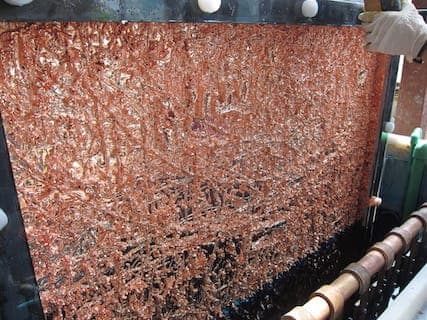
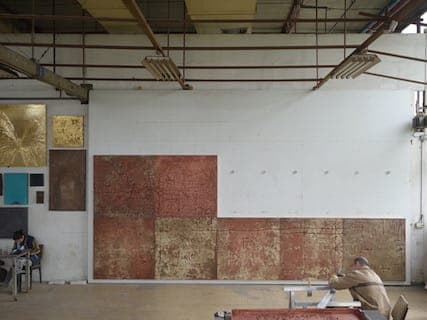

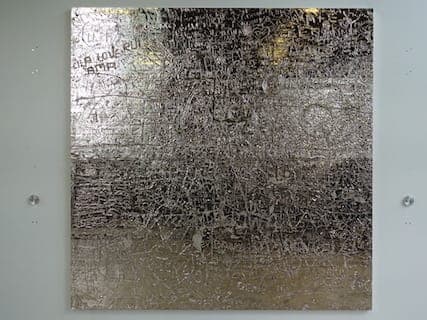
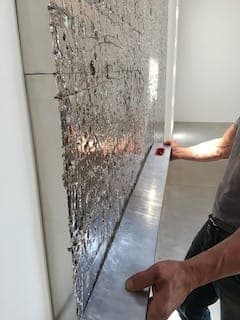
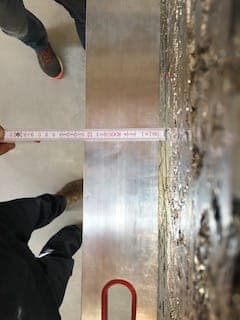
This is the setup we work with:
We have view acid sour copper tubs, from small to bigger scale (1100gallons). The largest piece we made in one piece was 7.3 by 6.2 ft. (230cm x 190 cm)
Most of the works we did by now where canvas like objects, 4 x 4 ft times 1.5 inches deep. We silver the the surface of the rubber moulds to make them conducting.
We use Enthone additives, work with filters the electrolyte is thermo controlled around 82 °F. Our normal deposit is around 0.08 inches of copper, forming with about 350A. We normally working with about 20 A/feet2 (2A/dm2)
Now we do have some problems and some things we never really found the answers for. Therefore I'd like to try to get some answers here.
1. we used to have more or less tension-free copper. Lately we experience our electroformed "panels" to have a concave or convex "stomach". As there would be too much surface material. We made several tests with straight flat objects like glass. The copper on the "mould" it looks fine and straight, when we de-mould the copper, it bends.
We didn't always experience that. The analysis are fine (content of copper, sulfuric acid, chloride and additives)
Does someone knows this problem? or maybe a solution for it?
2. we have sharp 90° angles in the mould (the edge of the panels) and by nature the edges are very thin and weak. Even more the corners.
Is plating with lower or higher currents better for this edges? Or would an alternating rectifier create a more even deposit in the edges and corners?
3. welding of electroformed copper is almost impossible (as I understand because of the hydrogen in the structure) is there a treatment to solve this problem?
thank you very much for your time!
- Saint Gallen, Switzerland
Can I use ANY epoxy?
Q. Hi I am just starting out in electroforming and am in the process of buying the necessary equipment etc. I obviously want to buy the best supplies but also don't want to pay a ridiculous amount unnecessarily. So can I use any epoxy or does it need to be a specific type?
Tanya NicholsonJewellery Designer - Southampton, UK
January 4, 2017
Q. Hi my name is Ronnie I have been trying to set up my own copper electroforming solution. I have been buying ready-made solution online and want to switch over to homemade. I have all the material I was just wondering what my pH has to be? I read the thread but could not find any info on it. Also I am looking for anode bags would anyone know where to get some ?
Ronnie ramirez- Oxnard, California, united states
January 6, 2017
A. Hi Ronnie. Although the suggested pH of nearly every plating solution is listed in the textbooks, I went through at least 6 or 7 of the best known texts searching for the pH of acid copper sulphate baths and came up empty. My conclusion is that the pH value must be considered distracting and non-useful. Control the sulfuric acid ratio rather than the pH.
Please use Google or a directory for vendors of "anode bags"; we don't suggest vendors in this forum (why?). Good luck.
Regards,

Ted Mooney, P.E. RET
Striving to live Aloha
finishing.com - Pine Beach, New Jersey
January 2017
for Artisans, Jewelry, Crafts

avail from eBay, AbeBooks or Amazon

avail from Amazon

avail from Amazon

avail from eBay, AbeBooks or Amazon

avail from eBay, AbeBooks or Amazon
(as an Amazon Associate & eBay Partner, we earn from qualifying purchases)
Q. Hello, I have a few questions.
1) How do you correct your copper solution if you have an organic contamination?
2) Also, how do you know when the pH level needs to be changed and how do you do so?
3) I use graphite paint and Midas copper electroforming solution. I've used this on silver, brass, copper etc.
I've seen silver conductive paint and solutions and it's way more expensive. At what point do you use those? Am I not supposed to use the graphite paint and solution on metals other than copper?
Thank you!
- Kona, Hawaii, USA
January 7, 2017
Q. Hi there,
I just started electroforming jewelry and had some success in some success. However, recently my pieces have been coming out not copper toned but salmony. I've already replenished with distilled water, and added more brightener. I also tried Dremel polishing and steel brushing the piece to try to bring out the copper colour but it just made it a shinier salmon colour … can anyone tell me why I can no longer achieve the rich gold tone?
Thank you!
- Vancouver, BC, Canada
March 12, 2017
Q. I have a piece I am electroforming. I need to leave and wondering if I can turn off rectifier and come back to it later? If so, can I leave it in the solution, or should I take out, rinse and let sit?
Thank you,
Rebecca
hobby, jewelry designer - Oceanside, California
June 17, 2017
A. Hi Rebecca. We appended your inquiry to a thread about electroforming of copper. Please confirm that you are doing copper electroforming from copper sulphate ⇦ this on eBay or Amazon [affil links] because, while that would probably be okay to interrupt, other processes like nickel electroforming would be ruined by such interruptions.
Regards,

Ted Mooney, P.E. RET
Striving to live Aloha
finishing.com - Pine Beach, New Jersey
![]() Yes, I am electroforming with copper electroforming solution
Yes, I am electroforming with copper electroforming solution
Thank you!
- Oceanside, California USA
Copper electroforming pinholes, grooves and flaws
Q. I am dong some copper electroforming on a small scale at home for a model engineering project. It is going quite well but I have trouble with the apparently random formation of odd little grooves, a few thou deep, sometimes connected to a pinhole. They are up to an inch long(usually shorter) and tend to run vertically. I can sand them out but this adds to the work.
I am using a standard acid electrolyte with levelers, chloride, etc., all to a known recipe. Current density is about 50 mA per sq inch. Total required thickness is approx. 0.5 mm and area of the cathode is 42 sq inch. I use anode bags but have not been using phosphorised copper, to save money. I have no way of analysing the bath.
The base material is a low melt tin/bismuth alloy which is melted out afterwards.The cathode shape is simple and smooth with no holes. The final copper sheath is strong enough and appears OK but needs a bit of sanding work to get it smooth. I can fill the worst flaws with solder and plate over but this is a nuisance.
Any ideas? Also can someone please tell me where the agitation bubbles should be placed relative to the cathode?
Many thanks
model engineer/hobbyist - Shepton Mallet, UK
October 15, 2017
What copper plating solution for electroforming 150 µ thickness?
This meeting place welcomes Q&As, photos, history, & interesting tidbits 🙂
Please engage with other posters
• When people show interest in each other's situations, the forum quickly becomes a fun & informative learning experience for everyone !
• But if posters show little interest in other people's situations, it can deteriorate into a string of unanswered questions
Q. Dear Sir
I want to do copper electroplating on polyurethane foam with more than 150 micron thickness.
What kind of bath solution do you propose? because, Most of copper electroplating solutions are used for less thickness.
- Meshad, Iran
November 30, 2017
Q. Hello. I'm just getting started and have done 2 pendants so far. The first one came out great and super shiny. The second next one came out dull! Even after trying to polish and put in tumbler. I did change the anode from a small sheet to copper wire coiled inside. The wire seemed to have a flaky layer coming off it and there also seems to be copper powder moving through solution. The wire and all my supplies are from Rio Grande. I have another in now and it's looking alright so far … but not shiny at all! When do you add brightener? I strained through coffee filter but how often does this need to be done? Also filtering through carbon?
Andrew smith- Winston Salem, North Carolina
December 19, 2017
Q. I have been playing around with electroforming small pieces of jewellery. I have successfully electroformed a ring and some earrings onto metal. I then tried out a conductive graphite paint specifically made for electroforming and it is not receiving the copper correctly.
My graphite paint test was on a leaf. It was first sealed with acrylic sealer that came from the same company as the graphite paint, left to dry for 24 hours (as stated in the instructions) and then the graphite was applied. The graphite paint seemed to pull the sealer off and leave an uneven finish in places. I left the paint to dry for another 24 hours (again, as instructed) and put it in the bath using the same method and amperage as my successful tests onto metal previously. The graphite seemed to come off into the solution a little and I could see little floating clouds of copper after a short while. After 10 hours (a lot longer than I had left the first test for) I pulled the leaf out and only a small amount of copper had transferred over and only where the conductive wire was directly touching and areas next to it.
My set up is as follows; Rectifier set at ~ 0.3 amps and 0.7 v; positive wire connected to a copper pipe resting across the bath with 1 mm copper wire hooked on with object to be electroformed fully submerged. Negative wire connected to two copper pipes in the bath. Looking at some diagrams I think I may have my positives and negatives the wrong way around. Is this detrimental to the process? If so, why was I able to get a successful test directly onto metal?
My real question is, what am I doing wrong. I believe that the paint and all of the chemicals are of good quality and I feel that the process isn't working due to my lack of knowledge. Is there anything in my process that screams out?
Looking for any advice.
Thanks in advance.
- Bristol, Somerset, UK
January 23, 2018
This meeting place welcomes Q&As, photos, history, & interesting tidbits 🙂
Please engage with other posters
• When people show interest in each other's situations, the forum quickly becomes a fun & informative learning experience for everyone !
• But if posters show little interest in other people's situations, it can deteriorate into a string of unanswered questions
Q. I have had success electroforming pieces in the past, but recently when I have been putting a piece in the bath the copper will only collect on the copper hook I have attached to my jewelry piece and not the piece itself. My jewelry pieces often consist of crystals coated in graphite paint.
I have an electroforming tank with a copper solution that I made myself:
For 1 gallon of distilled water-
32 oz. Copper sulphate
32 ml. Sulfuric Acid
10 ml. Brightener
I'm not sure if this is my problem, because I have successfully plated pieces before with this solution, but I can't think of what could be the problem because I have not changed anything else in the process.
Any help is appreciated, thank you!
- Chicago,Illinois, United States
May 9, 2018
Can electroplating rectifier be used for electroforming?
Q. I have access to three "old" Vigor electroPLATING controllers. Can these be used for electroFORMING? If so, what should I know about cross-purposing them?
Jann Greenland- Little Rock, Arkansas USA
July 7, 2018
A. Hi Jann. If they are in working order they should be fine. The biggest difference in electroplating and electroforming is just the name :-)
We call it electroplating if we put a metal coating on an object, for example a truck bumper or circuit board. We call it electroforming if the plating layer itself comprises the object, for example a hollow gold earring formed on a wax core or a stamper for vinyl records formed on, then removed from, the lacquer master. If you're doing a gold flower, some people will call it a plated flower and others will call it an electroformed piece of jewelry.
Regards,

Ted Mooney, P.E. RET
Striving to live Aloha
finishing.com - Pine Beach, New Jersey
Q. Hello,
I am hoping to use an older electroplating rig to do some electroforming on jewelry pieces. The problem is, the electroplater has only a single control knob. It has a DC Volts meter and a DC Amp meter, but only the single control knob. (It's an HR Superior 10 Amp Electro-Plater)
In my first test, I had the machine turned up about 20%, the volts showed zero, the amps constantly fluttered between 0 and 2. The copper that was deposited on the piece was flaky and had poor adhesion. The solution also heated up substantially during the process and I'm unsure if that's normal.
Do you have any advice on using this machine for electroforming or do I need to shell out for a more modern device that has independent v/a controls?
Thanks!
- Cambridge, Massachusetts, USA
July 17, 2018
A. Hi Wil. Ohm's Law says V = A*R, so there actually is no such thing as independent control of voltage and amperage anyway, although it is true that more sophisticated control systems might let you pick a particular amperage and have the power supply increase/decrease the voltage as necessary to hold it.
It's possible that an old unit is defective, of course, including the possibility that the voltmeter which read zero is broken (you probably only need 1 or 2 volts for your electroforming). But you could start troubleshooting by reading the voltage it's putting out with an external voltmeter. If the solution is heating up (which is normal), it is because of the power the rectifier is putting into the solution.
If you're certain that you have good connections to the anodes and the parts, yet the amperage is jumping all over, it may well be defective. But there are many possible causes for flaky & poorly adhering copper, and the rectifier is not the first place I would look unless there is good reason to believe it is bad.
Regards,

Ted Mooney, P.E. RET
Striving to live Aloha
finishing.com - Pine Beach, New Jersey
![]() Thank you so much for your response! It turns out that my entire plating supply died later the same day I wrote. I sourced a new power supply and my electroforming is now working just as I had hoped.
Thank you so much for your response! It turns out that my entire plating supply died later the same day I wrote. I sourced a new power supply and my electroforming is now working just as I had hoped.
Thank you again. I am finding finishing.com to be an excellent resource!
- Cambridge, Massachusetts USA
Tip: This forum was established to build camaraderie among enthusiasts through sharing tips, opinions, pics & personality.
The curator & some readers who publicly share their info will be less likely to engage with those who don't.
Need a Rectifier Substitute
Q. Hi, I'm interested in starting electroforming copper jewellery but I cannot find a rectifier anywhere. Are there any substitutes for a rectifier?
Dani Putter- Johannesburg, Gauteng, South Africa
August 29, 2018
A. Hi Dani. Your problem is surely not unavailability of plating rectifiers, but language differences such that you are not recognizing that available power supply devices qualify as what people are calling 'rectifiers'. You simply need an adjustable power supply which, depending on the size of your jewelry, can provide perhaps 5 Amps (or probably even less) at about 0-6 Volts (most offer higher voltage, but the lower the better). Good luck.
Regards,

Ted Mooney, P.E. RET
Striving to live Aloha
finishing.com - Pine Beach, New Jersey
Q. Hello. I make electroformed jewelry and I make my solution myself. Everything was going smooth till last night. I left the rectifier open on a low current to plate a pendant in a 1L solution. Current was about 0.2 amps and voltage was about 0.3 I think. In the morning most of the piece was plated the way I want but a small part of it was left above the solution (I don't know how but it evaporated more then usual I think).
And the part left outside looked like it was plated a thick layer of textured copper but when I touched it, It just crumbled. Not even crumbled, it was all squishy. Then I electroformed one more piece and same thing happened to the whole pendant. Why do you think it happened? Can someone help me please?
Cagin UcarChitta Studio - Turkey Canakkale
September 11, 2018
by Larry Durney

on eBay
(sometimes) or
AbeBooks
(rarely)
or Amazon
(sometimes)
(affil links)
A. Hi Cagin. When you go from satisfactory plating, to unsatisfactory, keep in mind Larry Durney's 'Logic of Troubleshooting':
"We can safely assume that a working system cannot become a non-working system without some change occurring"
In this case I think you're already 99% confident about what changed: the solution composition -- perhaps due to evaporation, extended run time, or something else. But you've not yet given us any information on that subject. Although it would be nice if people could tell us how to solve the problem of squishy plating from solutions of unknown composition, I don't think that's likely to happen. Get back to us please.
Regards,

Ted Mooney, P.E. RET
Striving to live Aloha
finishing.com - Pine Beach, New Jersey
A. Probably too low amount of copper. Maybe iron in solution can be cause too. Try fresh solution. Hope it helps and good luck!
Goran Budija- Zagreb,Croatia
September 13, 2018
Q, A, or Comment on THIS thread -or- Start a NEW Thread


